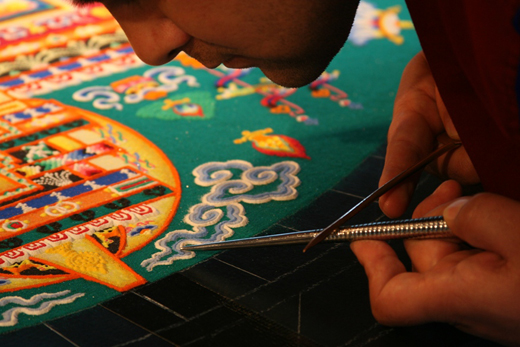Events
September 28, 2011
Ritual of life's impermanence captured in staff photo exhibit

Myron McGhee's photographs reveal the intricate designs, painstaking process and significance of Tibetan sand mandalas.
By Jessica Cook
In the Tibetan tradition of mandala sand painting, monks work side-by-side for days to painstakingly lay tiny, colorful sand particles into an intricately designed mandala. At completion, the mandala is dismantled by sweeping away the sands. This closing ritual is a metaphor for the impermanence of life.
Juxtaposed with the idea of impermanence are the more permanent photographs in Myron McGhee's exhibit, "The Mind's Eye," documenting mandala sand painting during Emory's annual Tibet Week.
McGhee, an experienced photographer and musician, is a circulation specialist at Pitts Theology Library '95T. His wife, Juana Clem McGhee, the Department of Middle Eastern and South Asian Studies academic department administrator '95T, conceived the idea for an exhibit—seeking funding and selecting photos from Myron McGhee's vast collection. For over 10 years, the McGhees have enjoyed the annual sand painting at Emory with their two daughters.
"It has become a wonder-filled tradition for our family, as our eyes are drawn to the exquisite beauty of their art, and as our minds are inspired by their religious devotion," says Juana McGhee.
Describing his photographic approach as "working quietly as witness, but rarely as an orchestrator," McGhee shows the rich colors and textures of this ancient art. The exhibit sequences the photos to tell a story, beginning with the opening consecration ceremonies led by Tibetan monks chanting. From there, his camera captures details we might miss if standing in a crowd: such as a close-up of sand grains being carefully placed on the mandala—or of the meditation beads on the monk's wrist, a reminder of the sacred nature of the mandala process.
The photographs reveal the intense focus of the artistic process, yet convey a feeling of stillness. During the sand-painting process, the monks devote their minds to meditation for the healing of the Earth and its inhabitants. McGhee says photographing in this sacred space raises his own consciousness: "Creating a narrative with images in such an intentional, meditative space gives rise to my own authentic voice, renews a sense of self and extends the dialogue with Creation's call."
The collection of photographs will be on exhibit at various venues on campus throughout the 2011-2012 academic year. "The Mind's Eye" recently showed at the Schwartz Center for Performing Arts and moves to the Center for Ethics on Oct. 3 through Oct. 31.
Center for Ethics Director Paul Root Wolpe says mandala sand painting teaches us "…the ephemeral nature of our lives and works through its ultimate destruction. The beautifully photographed record of the Emory sand mandala is itself a paradox—a permanent record of an art form intended to be temporary—and I am proud that the Center's gallery exhibit will give us the time and space to contemplate its aesthetic and philosophical complexity."
